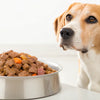Do Dogs Need Wet Food in Their Diet? Unpacking the Pros and Cons
- Houndsy
Table of Contents
- Introduction
- Understanding Dog Nutrition
- The Benefits of Wet Dog Food
- The Drawbacks of Wet Dog Food
- Can Dogs Thrive on Wet Food Alone?
- Mixing Wet and Dry Dog Food
- Taking the Lead: What to Consider
- Conclusion
Introduction
Did you know that nearly 60% of dog owners are unsure about whether to feed their dogs wet or dry food? If you’re one of these pet parents, you may have found yourself standing in the pet food aisle, staring at the myriad of options, wondering what is actually best for your furry friend. With both wet and dry dog food promising to provide complete nutrition, the question becomes more complex: Do dogs need wet food in their diet?
In this blog post, we will delve into the details of wet dog food, covering its nutritional value, processing methods, benefits, and potential drawbacks. Our aim is to equip you with the knowledge to make informed decisions regarding your dog’s diet while considering their unique needs.
By the end of this blog, you will have a clearer understanding of wet dog food, whether it could benefit your pet, and how to choose the right food options. So, let’s embark on a journey to discover whether wet food is a necessity or just an option in your dog's diet.
Understanding Dog Nutrition
The Basics of Canine Nutrition
Much like humans, dogs require a balanced diet for optimal health. Key elements in canine nutrition include protein, fat, carbohydrates, vitamins, and minerals. Each ingredient serves a specific purpose:
- Protein is essential for building and repairing body tissues, supporting immune functions, and providing energy.
- Fats are crucial for hormone production, skin health, and energy.
- Carbohydrates provide a readily available source of energy and support digestive health.
- Vitamins and minerals are vital for various bodily functions, from bone health to immune response.
Ensuring that our pets receive a nutritionally balanced diet is critical. With an understanding of canine nutrition, we can then explore how wet food fulfills these dietary needs.
Wet vs. Dry Dog Food: An Overview
When it comes to dog food, there are essentially two primary options: wet food (canned) and dry food (kibble). Each has its processing methods, benefits, and potential drawbacks.
Wet Dog Food: Typically contains a high moisture content, boasting about 75-78%, which can help to keep your dog hydrated. The major appeal of wet food lies in its palatability; the texture and aroma often entice picky eaters.
Dry Dog Food: Contains roughly 10-12% moisture and is known for its convenience and longer shelf life. Kibble can also assist in promoting dental health by reducing tartar buildup through the chewing process.
Incorporating both types into your dog’s diet may offer a balanced approach to their nutritional needs. Let's explore this deeper.
The Benefits of Wet Dog Food
Enhanced Hydration
One of the primary benefits of wet dog food is its high moisture content. Many dogs, especially those that don’t drink enough water, may benefit from this added hydration.
Consider the Case of Fido: For instance, if your dog seems lethargic and you suspect dehydration might be the issue, switching to a wet food could help them maintain better hydration levels.
Increased Palatability
Wet food is generally more flavorful and aromatic than dry kibble, making it an excellent choice for:
- Picky Eaters: Dogs that turn their noses up at dry kibble might find wet food more appealing.
- Sick or Older Dogs: Dogs with diminished appetites due to illness or aging can benefit from the rich aroma and soft texture of wet food, encouraging them to eat.
Nutritional Profile
Wet food can be a richer source of protein and fat compared to dry kibble, allowing you to offer your dog high-quality nutrition.
- Look for wet food varieties with high-quality ingredients, such as named meat sources and a balance of healthy fats and carbohydrates.
Ideal for Specific Health Conditions
Certain medical conditions necessitate a diet rich in moisture, protein, and easier to chew food:
- Dental Issues: For dogs suffering from dental problems, wet food may be easier to manage than dry kibble.
- Kidney Health: For dogs with kidney disease, increased moisture content can help with hydration and ease strain on their kidneys.
Weight Management
Wet food often has a lower carbohydrate content, making it a potential option for dogs needing weight management. The sensory experience of eating wet food may also promote satiety, helping dogs feel fuller with fewer calories.
The Drawbacks of Wet Dog Food
Cost Implications
One of the downsides of wet food is the higher price point compared to dry kibble. Feeding a dog primarily wet food can add up significantly, particularly if your dog weighs more or requires higher calorie intake.
Spoilage Factor
Wet food has a shorter shelf life once opened and generally cannot be left out for extended periods. For dogs that tend to graze, wet food may not be a suitable option. Additionally, leftovers should be refrigerated to avoid spoilage.
Dental Health Concerns
While wet food is beneficial in many ways, it does not promote dental health in the same manner as dry food. The lack of a crunchy texture means that wet food does not effectively help clean teeth, which may lead to tartar and plaque buildup if dental care is neglected.
Potential Additives
Many commercial wet foods contain fillers and preservatives that may not be ideal. Selecting high-quality brands is essential to ensure you’re not feeding your dog unnecessary additives.
Can Dogs Thrive on Wet Food Alone?
The short answer is yes; many dogs can thrive on a wet food diet alone, provided that the food is nutritionally complete and balanced. However, it is crucial to consider individual factors such as age, activity level, and any existing health conditions.
Remember that not all wet foods are created equal. Always opt for higher-quality brands with nutritious, whole ingredients, and consult your veterinarian for tailored advice.
Mixing Wet and Dry Dog Food
For many dog owners, combining wet and dry food can offer the best of both worlds. Mixing can capitalize on the benefits of both types while minimizing the drawbacks. Here’s how to do it right:
- Start Gradually: Transition your dog slowly over 7-10 days, beginning by mixing a small amount of wet food with dry to their meals.
- Monitor Portions: Keep track of calorie intake to avoid overfeeding and adjust the portions accordingly.
- Consider Preferences: Observe your dog’s reaction to the combined diet. Adjust meal components based on what they enjoy more.
Taking the Lead: What to Consider
Before making any changes to your dog's diet, we recommend considering the following:
- Individual Needs: Evaluate your dog’s lifestyle, age, weight, and health conditions to tailor food choices.
- Consult with Your Vet: A veterinarian can provide professional insights into dietary plans that suit your dog's specific requirements.
- Quality Over Quantity: Always prioritize high-quality food choices, whether wet, dry, or a mix of both.
Conclusion
In summary, while dogs do not need wet food, incorporating it into their diet can provide many benefits, from enhanced hydration to greater palatability. However, as with any dietary decision, it’s vital to consider your dog’s individual needs and preferences.
At Houndsy, we are committed to enhancing your pet's daily feeding experience with our beautifully designed Houndsy Kibble Dispenser, which ensures precise portion control and avoids the mess associated with feeding time. To explore our Kibble Dispenser and experience how we can simplify the feeding ritual—all while maintaining aesthetic appeal—check it out here.
FAQ
1. Is wet dog food more fattening than dry food?
No, it’s a common myth that wet food is more fattening. In reality, it often contains lower carbohydrates, making it a better option for weight management.
2. Can puppies eat wet food?
Yes, puppies can enjoy wet food. It provides necessary hydration and is easier to chew, particularly when they are weaning off their mother’s milk.
3. Should I mix wet and dry dog food?
Mixing can offer a range of textures and flavors, ensuring your dog's diet remains balanced and appetizing.
4. How can I ensure my dog gets enough hydration?
Both wet food and access to fresh water help ensure your dog stays hydrated. If your dog prefers dry food, consider offering wet food occasionally to boost their moisture intake.
5. What are good brands of wet dog food?
Look for brands that prioritize high-quality, whole ingredients and avoid fillers. Consulting your veterinarian can also help you prioritize the best choices for your dog’s specific needs.
By understanding the various facets of feeding our dogs, we can ensure they receive a fulfilling, balanced diet that enhances their well-being and quality of life.












